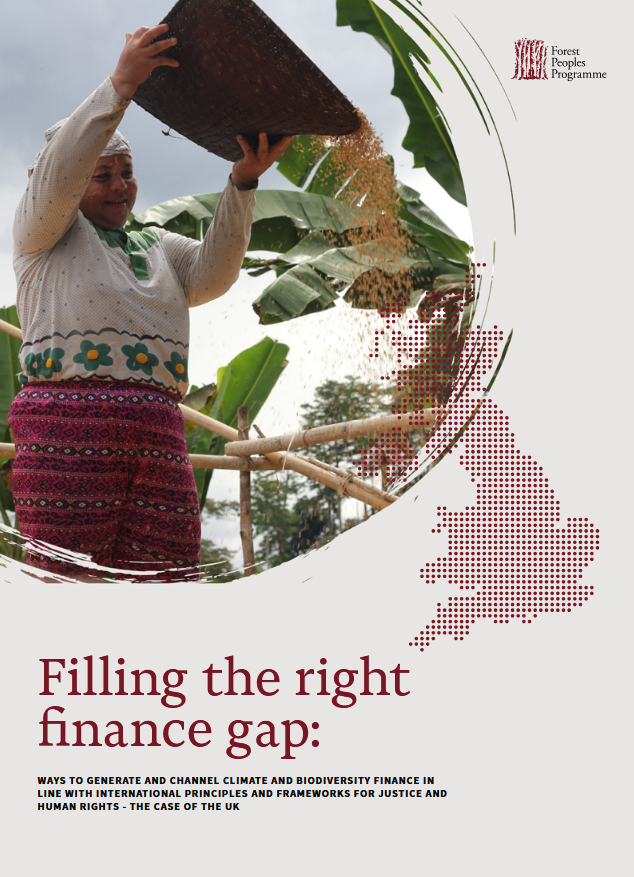
Filling the right finance gap
Ways to generate and channel climate and biodiversity finance in line with international principles and frameworks for justice and human rights - the case of the UK
Indigenous Peoples are disproportionately impacted by the climate and biodiversity crises while contributing least to it, and Global North countries, large corporations and wealthy individuals are disproportionately responsible for the emissions and destruction. If we don’t recognise this historical disparity through implementation of the common but differentiated responsibilities and polluter pays principles, there will be no climate justice.”
World leaders tell us that there is not enough finance to tackle the ever-escalating climate and biodiversity destruction. Authoritative studies estimate that the gap between the finance needed in the next few years and what is currently available is trillions of US dollars. The narrative presented is one of scarcity. The international response has been to set finance goals – under the international conventions on both climate and biodiversity. This has spurred a somewhat chaotic hunt for finance from all sources with a particular quest for elusive innovative finance.
This open-ended and all-encompassing language has, among other things, triggered a rush of ideas about how to ‘unlock’ finance, particularly from the private sector. A large focus is placed on ‘de-risking’ private sector investments through the use of public and philanthropic funds; the central question often being how to make private sector engagement profitable. One response is about to take center stage at COP30 – the Tropical Forest Forever Facility (TFFF). TFFF is surrounded by an air of promise – some seeing it as a savior in the context of significant cuts to Global North country Offical Development Assistance (ODA) budgets, with Indigenous Peoples and forest-dependent communities promised 20% of payments allocated for forest countries. Others are warning that the financial model is unjustifiably risky and, contrary to international climate justice principles, puts the burden of generating finance on Global South countries rather than Global North countries and corporate investors.1 They also explain that if the fund fails to generate the expected amount of finance, payments to forest countries are the first to be cut, as the priority will be to repay corporate and sovereign lenders.2
What if there is another way to generate finance to address the climate and biodiversity crises? A way that is more predictable, adequate, and which would enable Global North countries to pay their fair share by significantly bolstering public coffers? A way that would ensure that the world’s heaviest polluters take on a proportionate part of the bill but without betting on the invisible, or fictional, hand of speculative and volatile financial markets, or relying singularly on transforming climate and biodiversity action into a business opportunity.
This report encourages us to take a step back - to look at the bigger picture. Generating enough finance to hit the targets does not in itself guarantee that climate, biodiversity and human rights will be better protected. The extent to which climate and biodiversity finance can catalyse transformative reforms to harmful energy, extractive and economic systems must be the barometer of its utility.
Finance gap estimations are just that – estimations – and an undue focus on the zeroes is unhelpful. While questioning the accuracy of finance gap estimations and the utility of finance targets is important, it is not the topic of this report. Rather, the report takes the estimated finance gap as a starting point and reminds us that there is an abundance of finance that can be used to fill it. The problem is that vast amounts of finance are locked into uses that are harmful for climate, nature and people.
The key to unlocking climate and biodiversity finance is in the hands of the world leaders, who in November 2025 will meet both at UNFCCC COP30 in Belém and in UN Tax Convention negotiations in Nairobi. This report seeks to turn the spotlight back on the obligations and power of states – using the UK as the case in point – and shed some light on the tools at their disposal to generate new, additional, adequate, predictable and human rights-based finance for climate and biodiversity action. It looks at the potential for tax and subsidies reform to help Global North countries align with the principle of Common But Differentiated Responsibilities and Respective Capabilities and, through such reforms, to mandate wealthy heavy polluters to pay their fair share. Finally, the report also stresses that there must be a dramatic improvement in Indigenous Peoples’ access to finance generated through such measures, via modalities best suited to their circumstances. This is not only to ensure climate and biodiversity outcomes can be realised in a cost-effective way given their unique contributions to environmental conservation; it is also to respond to Indigenous Peoples’ long-standing and increasingly urgent calls for recognition of their collective rights and needs. Without this recognition, Indigenous Peoples’ unique capacity to continue, and to strengthen, the protection of their diverse territories and ecosystems, and by extension our collective futures, is jeopardised.
If world leaders are serious about looking for innovative mechanisms to unlock all sources of finance, they need look no further than the fiscal policy key that is already in their hands. With that they can free trillions of US dollars annually and earmark significant portions to climate and biodiversity action, with dedicated access windows that ensure proportionate amounts are distributed and spent in accordance with the priorities and self-determination of Indigenous Peoples. Given this has not happened to date, it fits squarely in the category of innovative finance.
1 Third World Network1 (2025). Review of the Tropical Forest Investment Fund
2 Larry Lohmann (2025). Spoils of a Continuing Colonialism: The Tropical Forest Forever Facility. The Corner House
Overview
- Resource Type:
- Reports
- Publication date:
- 7 November 2025
- Programmes:
- Climate and forest policy and finance

